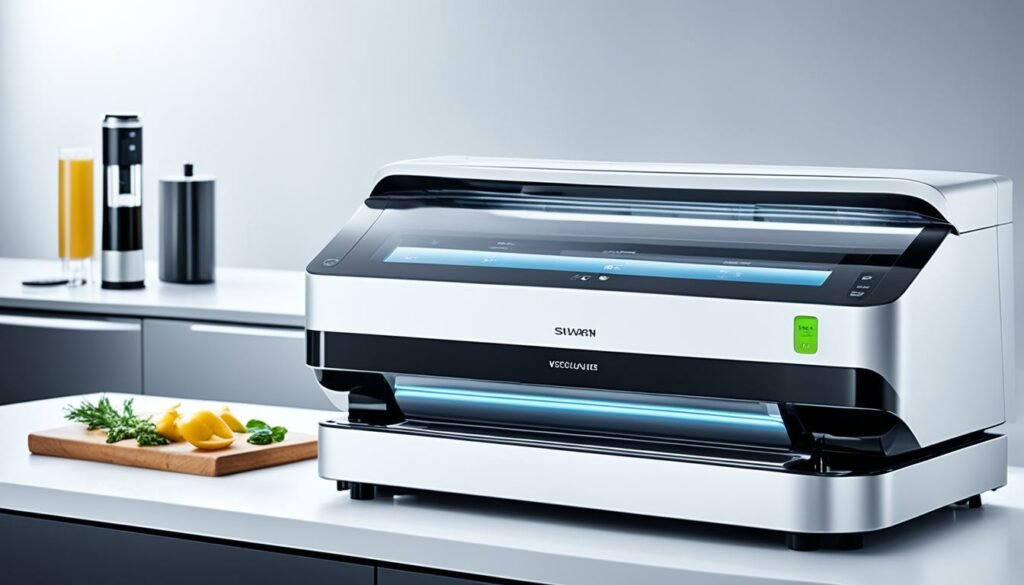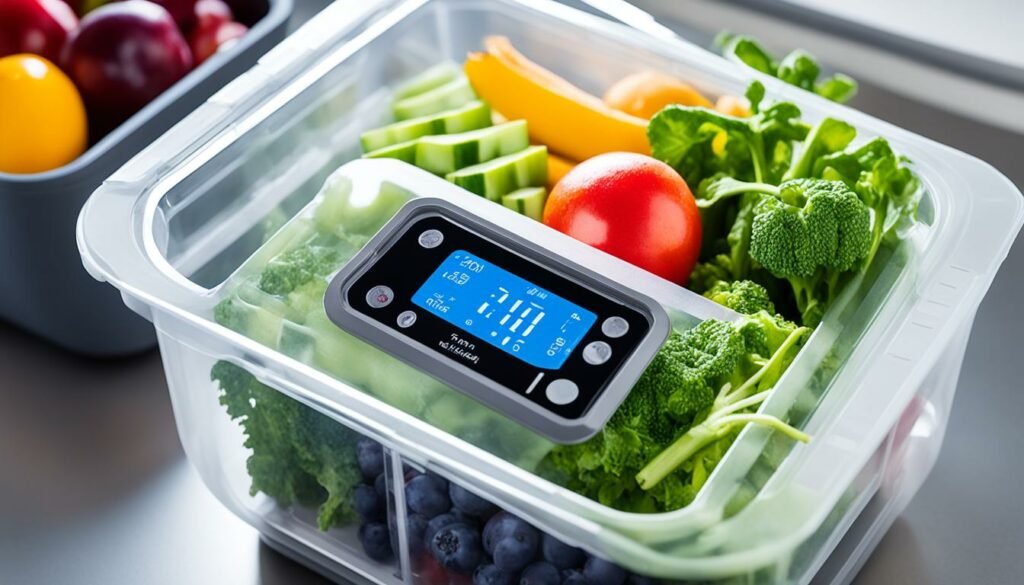Have you ever asked how food stays fresh longer or why medical items stay sterile when moving from one place to another? The secret is smart sensors used in vacuum sealing tech. They’ve changed our thinking about preserving and packing stuff.
Smart sensors are a big part of vacuum sealing. They are improving packaging through the Internet of Things (IoT). With innovations like Wafer-Level Vacuum Packaging (WLVP), sensors are becoming more sensitive and, yet, they don’t cost more. This means packaging will get better without being bulkier or pricier. Just think, soon, every item we pack will be done with the exactness needed, thanks to sensors. And this trend is just starting.

Introduction to Smart Sensors in Vacuum Sealing Technology
Modern vacuum sealing is very different from how it used to be. It has moved from die-level to wafer-level packaging. This change has made the packaging process smaller, lighter, and cheaper. Thanks to new sensor technology, sensors can now be integrated into the packaging process much more closely than before.
This integration allows for smarter and more reliable packaging. It’s not just a seal anymore; it’s an automated process filled with sensors.
The Evolution of Vacuum Sealing Technology
Vacuum sealing has come a long way, from manual sealing to today’s automated systems. Smart sensors have been a big part of this change. They let machines keep an eye on how things are going and make adjustments as needed. This ensures packages are always sealed the best they can be.
Moving from separate sensor parts to one all-in-one chip has been a game-changer. It means machines can be more sophisticated. This is a big plus for devices that need a lot of connections, like the micro-mirrors found in new cameras.
Importance of Smart Sensors
Can you imagine sealing packages without smart sensors today? They’re crucial for making sure machines are doing their job perfectly. They’re what makes automated sealing systems work well and without errors. By using these sensors, companies can make their packaging more efficient and better quality.
Moving from old ways to smart sensors has brought huge benefits. Not only are these systems easier to understand and more affordable, but they also work a lot better.
Below is a comprehensive look at the comparative features of traditional and modern vacuum sealing methods.
| Feature | Traditional Methods | Modern Methods with Smart Sensors |
|---|---|---|
| Control Type | Manual | Automated |
| Monitoring Capability | Minimal | Advanced real-time |
| Efficiency | Lower | Higher |
| Cost-Effectiveness | Moderate | High due to reduced SWaP-C |
| Integration Complexity | High | Low with MEMS |
How Intelligent Packaging Systems Utilize Smart Sensors
Intelligent Packaging Systems use smart sensors to change how we keep products fresh and safe. They are key to keeping product quality high and people safe. They work by using new and clever technologies.
Components of Intelligent Packaging Systems
These systems are built with key parts for them to work well. Some of the important pieces are:
- Pressure sensors
- Thermal imagers
- Resonance devices
By using MEMS technology, these parts can carefully control the packaging. They make sure the right pressure is kept. This perfect control keeps products safe and in good shape.
Benefits for Consumers and Manufacturers
Both customers and makers benefit from Intelligent Packaging Systems:
- For consumers: Knowing products are safe is what matters most. The smart packaging watches over the products all the time. It helps stop them from going bad or getting unsafe.
- For manufacturers: These systems make making and watching over products easier. They get helpful data that makes managing goods and decisions better.
| Component | Function in Packaging | Technology |
|---|---|---|
| Pressure Sensors | Maintain ambient pressure | MEMS technology |
| Thermal Imagers | Monitor temperature | Infrared imaging |
| Resonance Devices | Track structural integrity | Resonance frequency |
These components together create very reliable Intelligent Packaging Systems. They get better over time thanks to new data they keep getting. This keeps people and products safe and top quality.
The Role of Automated Sealing Processes in Modern Packaging
Automated sealing processes are key in today’s packaging solutions. They cut down on manual work and mistakes. Thanks to smart sensor tech, the precision of these seals is unmatched. This leads to better control and quality, keeping products fresh and safe.
Efficiency Gains
Automatic sealing brings big efficiency boosts. It cuts production time from hours to minutes. This fast-tracks supply chains, speeding up orders and market times. With automatic bagging machines, there’s less waste, making operations greener. Automated quality checks also keep bad products from reaching customers, helping companies build strong brands.
Precision Sealing Controls
Good sealing controls are vital for top quality. They use exact measuring to pack items just right. This means less air inside, reducing leaks and keeping products fresh. New vacuum packing machines are energy-efficient and food-safe. These improvements boost cleanliness and cut down on health risks in food and drug packaging.
Automated systems also handle printing barcodes and QR codes. This makes tracking and managing inventory easier, cutting down on errors. With no need for extra labels, workflows are simpler and costs are lower. This leads to more efficient production and happier customers.
Packaging techniques are always changing to meet new needs. Automated seals are a big part of this shift towards efficient and eco-friendly packaging.
Sensor-Enabled Food Preservation Techniques
Sensor-enabled preservation changes how we keep food safe and fresh longer. Smart sensors in packaging watch oxygen, moisture, and temperature. This keeps food in the best conditions, making it last longer.

In this area, using phosphorescent oxygen sensors is a big step forward. These are in smart packages and check oxygen without harm. This accurate data is key for food safety and quality.
Putting smart sensors in packaging is good for both buyers and sellers. It means you can trust the food is fresh and safe. And for sellers, it cuts down on wasted food, saving money and helping manage stock better.
Here’s how these new methods help with food safety and shelf-life:
| Technique | Food Safety Impact | Shelf-Life Extension |
|---|---|---|
| Phosphorescent Oxygen Sensors | Highly Effective | Significant |
| Moisture Monitoring | Moderate | Moderate |
| Temperature Regulation | Critical | Crucial |
Sensor-enabled methods tackle the big challenge of keeping food safe longer. They use new tech like oxygen sensors and intelligent packages. This ensures our food is fresh and secure. It brings peace of mind to shoppers and helps sellers work better.
Types of Vacuum Sealing Monitoring Devices
Various devices help keep packaging airtight. This prevents outside air and dirt from getting in. The top technologies for this are pressure sensors and thermal imagers.
Pressure Sensors
Pressure sensors are key for checking small changes in vacuum levels. They guard against seal damage by keeping a close eye on pressure. During packaging, they make sure the pressure stays right for safe seals.
In laser welding, the pressure under a vacuum needs to be highly controlled. Pressure sensors are precise, catching tiny pressure changes. This catches leaks early, upping the quality of vacuum-sealed packages.
Thermal Imagers
Thermal imagers track heat patterns in packaging. They spot areas with odd temperatures, hinting at bad seals. This tech helps find leaks early, stopping product damage.
For instance, it’s critical in the MEMS world, with glass bonding done at high temperatures. Precise temperature checks are a must. This makes sure products are sealed and protected well.
Combining thermal imaging and pressure sensors boost vacuum sealing. This duo not only finds leaks but also makes vacuum sealing work better. It keeps products safe and fresh.
Packaging Data Analytics for Enhanced Performance
Packaging data analytics have changed how businesses boost their performance. With data, they can fully use their packaging systems. Smart sensors play a key role, offering real-time monitoring for a detailed analysis. This means quick feedback when performance needs a tweak.
Real-time Data Collection
Real-time data collection is a big deal in packaging. Smart sensors give companies immediate info on how their packaging machines are doing. They help with quality control and keeping machines running their best. Responding to this data fast lets companies make quick fixes, cutting down on wasted time and money.
Long-term Performance Tracking
But, just tracking short-term data isn’t enough. It’s also important to keep an eye on long-term patterns to improve. Collecting data over time gives lots of info for strategy. Companies can watch how things change and use this to get better nonstop. They can predict when maintenance is needed, find the best packaging, and fine-tune the whole packaging system for top performance and savings.
With careful use of packaging data analytics, companies can polish their ways of working. They get insights to make smart, data-backed choices, improving how well they do very efficiently.
FAQ
What are Smart Sensors in Vacuum Sealing Technology?
Smart Sensors are at the heart of vacuum sealing tech. They watch over important factors like pressure and temperature. This helps seal packages just right. They are key for smart packaging and sealing machines.
How do Semiconductor Sensors contribute to the Internet of Things (IoT) in Packaging?
Semiconductor Sensors are vital for adding packages to the IoT. They collect real-time data and help packages connect to the internet. This makes packaging smarter, leading to better maintenance and efficiency.
What is Wafer-Level Vacuum Packaging (WLVP) and its significance?
WLVP seals sensors tightly under vacuum. Because of this method, sensors work better, are smaller, and cheaper to make. This process is great for making lots of devices that need sensors.
How has vacuum sealing technology evolved?
Vacuum sealing has gone from old die-level ways to using advanced technology. New sensor and circuit integration has made sealing more efficient. This has changed how well and how fast we can seal things.
Why are smart sensors important in vacuum sealing technology?
Smart sensors bring better control and monitoring to sealing. They make packaging systems more reliable and improve automation. They keep seals high-quality, which keeps products safe and fresh longer.
What components are essential in Intelligent Packaging Systems?
Intelligent Packaging Systems need pressure sensors, thermal imagers, and other high-tech devices. They work together to keep the package’s environment just right. This keeps the product safe and in top condition.
What benefits do Intelligent Packaging Systems offer to consumers and manufacturers?
Consumers get safer products thanks to constant monitoring. For makers, there’s better efficiency and control in packaging. They can also use real-time data and manage their stock better.
How do Automated Sealing Processes improve efficiency?
Automated sealing cuts down on manual work and errors. It keeps the seals high-quality every time. This makes packaging faster, cheaper, and more reliable for making products.
What are the advantages of Precision Sealing Controls?
With smart sensors, you can carefully watch and adjust package sealing. This keeps quality high, extends shelf life, and avoids bad seals. It’s all about making sure the packaging is perfect.
How do sensor-enabled preservation techniques enhance food safety?
These techniques watch oxygen, moisture, and temperature levels. They make sure food stays fresh and safe. By extending shelf life, they also help in waste reduction.
What types of Vacuum Sealing Monitoring Devices are used?
Tools like pressure sensors and thermal imagers keep an eye on vacuum sealing. Pressure sensors check the seal’s strength, while imagers find weak spots. They help make sure seals are durable and well-made.
How does Packaging Data Analytics enhance performance?
By using smart sensors, Packaging Data Analytics gives real-time insights. This helps in quick fixes and in-depth trend analysis. It makes packaging more efficient and cheaper by using data in decisions.
